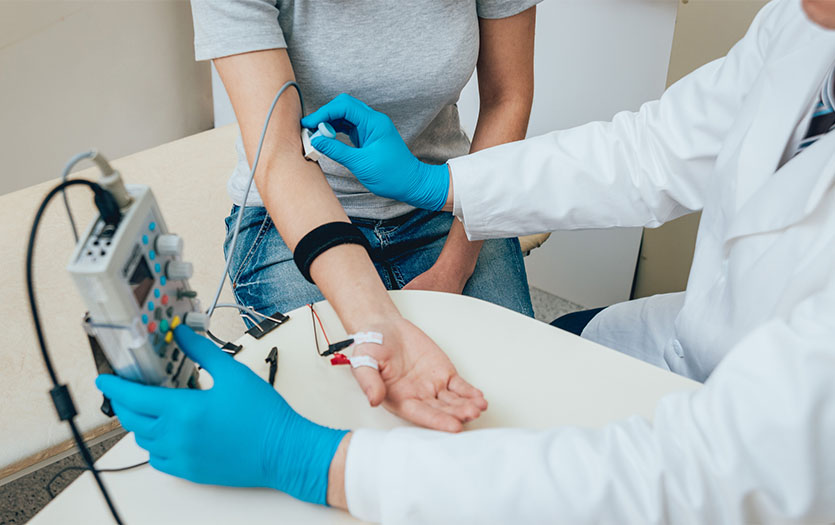
This post was written by Lawrence “Larry” Kennedy, MD, PPG – Parkview Physical Medicine & Rehabilitation.
Electromyography (EMG) measures muscle response or electrical activity in response to a nerve's stimulation of the muscle. In this introductory post, we’ll discuss what’s involved from a clinical perspective, the symptoms that might prompt EMG testing and the conditions often discovered through the procedures.
Understanding the procedure
With an EMG study, we are testing the peripheral nervous system as opposed to the central nervous system
The central nervous system, consisting of the brain and spinal cord, acts as the body’s command center and is protected by bone and protective membranes.
The peripheral nervous system comprises nerves branching throughout the body, and as it lacks bony protection is more vulnerable to injury. These peripheral nerves include motor nerves that control your muscles and movement, and sensory nerves that carry signals to your brain about things you touch, taste, smell and see.
EMG involves two procedures:
Nerve conduction study
During the nerve conduction study, small electrical currents are applied to specific nerves by a stimulator and surface electrodes are placed on the skin to record the response. These electrical impulses stimulate the nerves, and the resulting responses are recorded and analyzed.
Needle exam
For the needle examination, very fine needles are inserted through the skin into the muscle. The electrical activity of the muscle is then sent to a monitor that displays it in the form of waves. An audio amplifier is used so the activity can also be heard.
We observe both the sight and sound of the electrical activity with the muscle at rest and contracted.
Why would someone need an EMG study?
People are often referred for an EMG study because they are experiencing symptoms such as:
- numbness
- tingling
- pain
- weakness
- muscle cramping
Most of the time, these are felt in the extremities – the hands, feet, arms and legs. There are instances when patients experience symptoms in their face (involving the cranial nerves), such as Bell’s palsy, which presents with facial weakness.
Diagnostic testing
An EMG study is one piece of the diagnostic puzzle and is often used in conjunction with other means of analysis to confirm a diagnosis so the patient can get the proper intervention.
Entrapment neuropathies
The most common conditions we detect with EMG procedures are entrapment neuropathies, with carpal tunnel syndrome being most prevalent. Common entrapment neuropathies include:
-
carpal tunnel syndrome – involves the median nerve at the wrist
-
cubital tunnel syndrome – involves the ulnar nerve at the elbow
-
Peroneal neuropathy – involves the peroneal nerve as it wraps around a bony prominence (the fibular head of the tibia bone) in the lower leg
Radiculopathy
The second most common abnormality we detect with EMG testing is radiculopathy, which is essentially a pinched nerve occurring at or near the root of the nerve, shortly after its exit from the spinal cord either in the neck or low back.
When radiculopathy is in the lower back, patients often have pain down the leg, called sciatica. A pinched nerve in the neck often causes symptoms downstream in the arm or forearm or hand.
Peripheral neuropathies
Another category of diagnoses we can detect are peripheral neuropathies. These diseases can be seen with diabetes (which is the most common cause of peripheral neuropathy), excessive alcohol use, thyroid disease, vitamin deficiencies and certain medications. It can also be genetic ( hereditary neuropathies ). At times no known cause can be established.
Myopathies
Myopathies are diseases of the muscle itself. These can be inherited (e.g. muscular dystrophies) or acquired (e.g. polymyositis).
Neuromuscular junction
This is the connection point between the nerve and the muscle. An example of disease of this junction is myasthenia gravis.
Want to learn more?
If you are experiencing symptoms, speak to your primary care provider. Patients do not need a referral to undergo EMG testing, but it is helpful to work with your full care team in your pursuit of a diagnosis and subsequent treatment plan.
